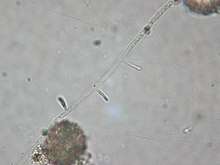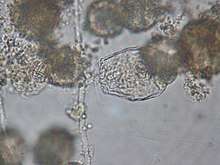Zoophagus
Zoophagus is a genus of zygomycete fungi that preys on rotifers and nematodes. It was established in 1911 by Sommerstorff, who originally considered it to be an oomycete. It is common in a variety of freshwater habitats, such as ponds and sewage treatment plants.[2]
| Zoophagus | |
|---|---|
 | |
| Hyphae of Zoophagus sp. displaying the lateral traps that rotifers get stuck on. | |
| Scientific classification | |
| Kingdom: | Fungi |
| Subdivision: | Zoopagomycotina |
| Class: | Zoopagomycetes |
| Order: | Zoopagales |
| Family: | Zoopagaceae |
| Genus: | Zoophagus Sommerstorff |
| Type species | |
| Zoophagus insidians Sommerstorff[1] | |
Morphology
The mycelium is composed of non-septate hyphae that bear lateral adhesive pegs. Spores are sometimes septate long, fusiform merosporangia with tapered ends that are borne on lateral sporangiophores.[3][4]

Ecology
Zoophagus species have been reported from ponds, brooks, and fens, usually in association with algae or decaying plant matter.[2][5][6][7][8][9] Exceptions are Z. cornus, which was described from rice paddy mud, and Z. pectosporus, which was described from moss and additionally reported from leaf litter.[10][11][12] Zoophagus insidians in particular has also been reported from sewage treatment plants where it can pose a significant threat to water quality.[2][13] Zoophagus spp. prey on a variety of rotifer species.[2] Zoophagus pectosporus primarily preys on nematodes and seems to be restricted to species of Bunonema, though it is also capable of trapping rotifers.[11][14] When prey encounter one of the traps, an adhesive is released and the animal is caught. Hyphae later grow into the body and digest it.[2]
Species
- Zoophagus insidians Sommerstorff – type species
- Zoophagus cornus Glocking
- Zoophagus pectosporus (Dreschler) M.W. Dick
- Zoophagus tentaclum Karling
- Zoophagus tylopagus Xing Y. Liu & K.Q. Zhang
References
- Sommerstorff, H. (1911). "Ein Tiere fangender Pilz". Österreichische Botanische Zeitschrift. 61: 361–373. doi:10.1007/bf01643971.
- Alexopoulos CJ.; Mims SW.; Blackwell M. (1996). Introductory Mycology (fourth ed.). John Wiley & Sons, Inc. pp. 161–162.
- "Zoophagus". Gerald L. Benny. Retrieved 2018-12-31.
- Dick, M.W. (1990). "The systematic position of Zoophagus insidians". Mycological Research. 94: 347–354. doi:10.1016/s0953-7562(09)80360-2.
- Prowse, G.A. (1954). "'Sommerstorffie spinosa and Zoophagus insidians predacious on rotifers, and Rozellopsis inflata, the endoparasite of Zoophagus". Transactions of the British Mycological Society. 37: 134–150. doi:10.1016/s0007-1536(54)80039-8.
- Morikawa, C.; Saikawa, M.; Barron, G. (1993). "Fungal predators of rotifers--a comparative study of Zoophagus. Lecophagus, and Cephaliophora". Mycological Research. 97: 421–428. doi:10.1016/s0953-7562(09)80129-9.
- Karling, J.S. (1936). "A new predaceous fungus". Mycologia. 28: 307–320. doi:10.1080/00275514.1936.12017145.
- Sparrow, F.K. (1952). "Phycomycetes from the Douglas Lake region of northern Michigan". Mycologia. 44: 759–772. doi:10.1080/00275514.1952.12024235.
- Tanabe, Y.; O'Donnell, K.; Saikawa, M.; Sugiyama, J. (2000). "Molecular phylogeny of parasitic zygomycota (Dimargaritales, Zoopagales) based on nuclear small subunit ribosomal DNA sequences". Molecular Phylogenetics and Evolution. 16: 872–884.
- Glocking, S.L. (1997). "Zoophagus cornus: a new species from Japan". Mycological Research. 101: 1179–1182.
- Dreschler, C. (1962). "A nematode-capturing phycomycete with distally adhesive branches and proximally imbedded fusiform conidia". American Journal of Botany. 49: 1089–1095. doi:10.1002/j.1537-2197.1962.tb15051.x.
- Saikawa, M.; Morikawa, C. (1985). "Electron microscopy on e nematode-trapping fungus, Acaulopage pectospora". Canadian Journal of Botany. 63: 1386–1390. doi:10.1139/b85-192.
- Pajdak-Stos, A.; Wazny, R.; Fialkowska, E. (2016). "Can a predatory fungus (Zoophagus sp.) endanger the rotifer populations in activated sludge?". Fungal Ecology. 23: 75–78. doi:10.1016/j.funeco.2016.06.005.
- Saikawa, M.; Yamaguchi, K.; Morikawa, C. (1988). "Capture of rotifers by Acaulopage pectospora, and further evidence of its similarity to Zoophagus insidians". Mycologia. 80: 880–885. doi:10.1080/00275514.1988.12025743.